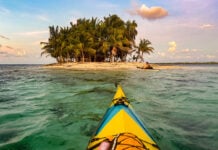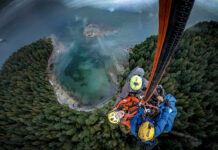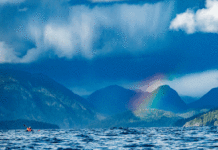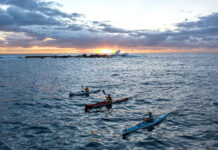Feathercraft ended 40 years of production in 2016, marking the end of an era in the sea kayaking world. Fortunately, many Feathercraft kayaks continue to thrive on the expedition scene because the unique folding design allows them to be transported to places hardshell boats simply can’t go.
Light—and sturdy—as a feather
Doug Simpson, Feathercraft founder and designer, invented the skin-on-frame foldable kayak design while working as a prospector and pilot in the remote wilderness of Canada’s Northwest Territories.
He wanted a lightweight, packable boat to load into float planes, that was quick to assemble and disassemble, and durable enough to last in the remote Canadian wilderness.
His patented his first design in 1977. He chose the name Feathercraft as an ode to a feather’s sturdy, hollow vane, like the tubes used in the frame.
The most popular Feathercraft design was the K2 Expedition tandem kayak. The K2 weighed 87 pounds and had a capacity of 700 pounds, making it ideal for extended expeditions with extensive food and gear requirements.
The early years of Feathercraft
During his early design years, Simpson rented a small shack on Granville Island in Vancouver, British Columbia. The space was 19 feet and three inches in length, which determined the maximum length of kayak he could build. To work on the opposite side of the boat, Simpson had to take the kayak outside, turn it around and squeeze it back into this shop.
Simpson chose T-6 anodized aluminum for the frame material, a common material for airplane parts. It has a high strength to weight ratio, and most importantly, is resistant to pitting and corrosion by salt water. The hypalon and urethane skin was all hand-cut and sewn. Thanks to high-quality components, Feathercraft kayaks regularly lasted for 30 years or more with proper maintenance.
Feathercraft kayaks are at home in the Arctic
I have been paddling Feathercrafts for many years in the Arctic. There certainly are tricks and quirks about building them, maintaining them on an expedition, and storing them. The manual suggests a 45-minute time for assembly.
In the field, with sometimes damaged or missing parts or in bad weather, this process can take quite a bit longer, and cost a few skinned knuckles along the way. Yet, as expedition boats, they are user-friendly—easy for packing and ideal for large cargo volumes. I have landed them in the surf, bashed through thick brash ice, and felt them flex in the large ocean swell.
I have also had a few mishaps. Luckily, field repairs are easy, and often permanent. The old saying holds true: take care of your boat, and your boat will take care of you.
With the high price of air cargo, most Feathercrafts still in service are cached high in the Arctic, or in holds of expedition cruise ships.
Salute to Pinky
This past summer, I took a moment to salute one of the Feathercrafts in our long-standing East Greenland fleet. Pinky, as it was aptly named in recent years, was a first-generation K2 Expedition kayak with a woven nylon skin. It had seen many sea days over its years of service, and its once deep red hull is now a sun-faded and salt-stained pink.
Pinky’s last trip was in the Ammassalik Fjord on the East Coast of Greenland. It was transported from Ittoqqortoormiit, Greenland, further north, where it previously served as an expedition fleet boat for more than two decades years.
During the long voyage, which included a snowmobile trek through two mountain passes, Pinky sustained two injuries to critical frame components. Even with careful hands and a delicate touch, these components failed while it was being dismantled. A short service was held for Pinky beside the sea, and a salute made to the many miles traveled, and many amazing things seen from its cockpit. Most of Pinky’s parts were donated to other Feathercrafts, so in a way, it will live on as a part of the fleet. At sea, where it was meant to be.
This article was first published in Issue 56 of Paddling Magazine. Subscribe to Paddling Magazine’s print and digital editions, or browse the archives.
Made in Canada. Paddled everywhere. | Feature Photo: Steve Ruskay









Doug Simpson did not design and/or invent this kayak, actually he copied it. Klepper was the first folding kayak and it was produced in Germany around 1907 by a then famous tailor. The design has been copied again and again. At one point there were over 60 different manufacturers in Germany alone.
Doug Simpson didn’t invent the genre, but he adapted it significantly using modern, high quality materials and then improved Feathercrafts with even better materials and techniques over 40 years of operation. He also developed two coaming designs that allowed most of his boats to be used with common spray skirts that are as water tight as those used on hard shells. As I recall he did a lot of development work on rudders used on hardshells and folding kayaks as well.
The beauty of the Fearhercraft designs is that they use modern materials, but are field reparable and, as the article suggests, parts can be readily scavenged and swapped in the field.
Yes, Kim Schmutzler is correct. A good friend of mine, Eric Stiller, founder, instructor and proprietor of Manhattan Kayak + SUP here in NYC has a family legacy tied to Klepper: His father Dieter owned and ran the Klepper shop here in Union Square for decades. Eric also co-paddled halfway around Australia in a Klepper tandem and wrote a book on the subject (“Keep Australia On Your Left”, which stares down at me from my bookshelf as I write this). As a journalist, and a fairly poor one when I bought my first folding boat, I’ve made quite the study of many makes of folding kayaks, and looked enviously at more than a few Feathercrafts, Kleppers and Long Hauls. I admired their materials and construction but bought a Folbot G2 as my first boat in the year 2000. I bought it because it was more affordable. It now has several thousand miles on it, between the Hudson River, Southern California and the northern Gulf of Mexico (though never the Arctic). It has been out in every season, including in winter ice on the Hudson, has landed hard on several beaches near San Diego, has been under sail on both the Atlantic and Pacific and has said hello to some very curious manatees who did not quite know what to make of the hypalon hull (“are you a manatee?”). I was sad to see all three of the longest-lived folding manufacturers go out of business. My fleet today contains three Folbots, an inflatable SUP and a hard hull Waterman C4 racing board. A constant tinkerer and amateur boat repairer, I readily admit to having made all sorts of repairs to my boats over the years (of late I always keep my eyes out for bits of the above mentioned T-6 to add to my repair kits). I also readily admit to having studied a friends Long Haul cables and copied them w/hardware and wire procured at West Marine. All this is to say that there is just something about folders feeling one step closer to being living things. Thanks for the story.
Indeed, the folding kayak was not Simpon’s original efforts, but like the Model T, his improvements far surpass the clumsy, clunky and uncomfortable Klepper and other Klepper copy-cats. His sleek design and construction methods were unique and innovative. I have a first edition K2 and it’s still in awesome shape. I paddled Kenai Fjords in a Klepper out of necessity and wished every moment that I could be in a Feathercraft!
I have used Kleppers for many years on the BC coast and can attest to their quality and seaworthiness. I have also used Feathercrafts for decades on trips to many places around the globe. The Feathercrafts went on as regular baggage for most commercial airlines, boats, and trains. Their quality of construction, design and on water performance outdid Kleppers by a large margin. In big seas a loaded K2 was the best and most comfortable boat imaginable. The K2 sail rig was simple and amazing. Doug made us a K3 for our young daughter which worked amazingly well for a number of South Pacific trips. The Feathercraft era will live on…
Appreciate the article! I have 2 Kahuna’s that were barely used that I need to pull out of storage (in their packs) after many years. Will need to see what condition they are in. Suspect that with a little work (certainly the elastic cords may need replacement or shortening) hoping they can become viable again. Moved on to packrafts years ago and an inflatable kayak (much faster to set up), but always loved these boats and the whole range of boats offered by Feathercraft.